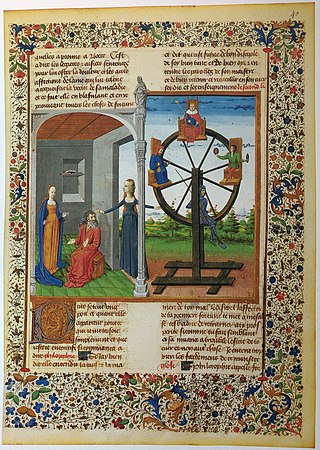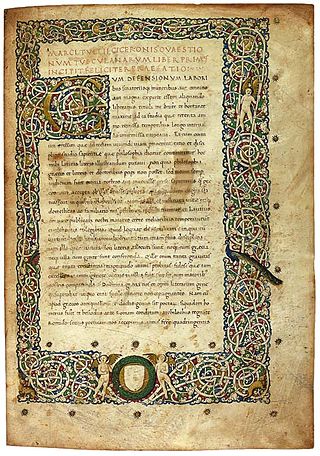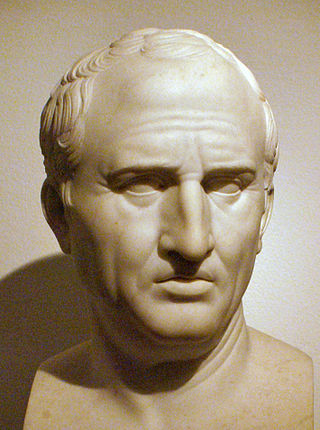Related Research Articles

On the Consolation of Philosophy, often titled as The Consolation of Philosophy or simply the Consolation, is a philosophical work by the Roman philosopher Boethius. Written in 523 while he was imprisoned and awaiting execution by the Ostrogothic King Theodoric, it is often described as the last great Western work of the Classical Period. Boethius' Consolation heavily influenced the philosophy of late antiquity, as well as Medieval and early Renaissance Christianity.
Latin literature includes the essays, histories, poems, plays, and other writings written in the Latin language. The beginning of formal Latin literature dates to 240 BC, when the first stage play in Latin was performed in Rome. Latin literature would flourish for the next six centuries. The classical era of Latin literature can be roughly divided into the following periods: Early Latin literature, The Golden Age, The Imperial Period and Late Antiquity.

Libanius was a teacher of rhetoric of the Sophist school in the Eastern Roman Empire. His prolific writings make him one of the best documented teachers of higher education in the ancient world and a critical source of history of the Greek East during the 4th century AD. During the rise of Christian hegemony in the later Roman Empire, he remained unconverted and in religious matters was a pagan Hellene.

Lucius Annaeus Seneca the Younger, usually known mononymously as Seneca, was a Stoic philosopher of Ancient Rome, a statesman, dramatist, and in one work, satirist, from the post-Augustan age of Latin literature.
Crantor of Soli was an Ancient Greek philosopher and member of the Old Academy who was the first philosopher to write commentaries on the works of Plato.
Lucius Annaeus Seneca the Elder, also known as Seneca the Rhetorician, was a Roman writer, born of a wealthy equestrian family of Corduba, Hispania. He wrote a collection of reminiscences about the Roman schools of rhetoric, six books of which are extant in a more or less complete state and five others in epitome only. His principal work, a history of Roman affairs from the beginning of the Civil Wars until the last years of his life, is almost entirely lost to posterity. Seneca lived through the reigns of three significant emperors; Augustus, Tiberius and Caligula. He was the father of Lucius Junius Gallio Annaeanus, best known as a Proconsul of Achaia; his second son was the dramatist and Stoic philosopher Seneca the Younger (Lucius), who was tutor of Nero, and his third son, Marcus Annaeus Mela, became the father of the poet Lucan.
Aulus Cremutius Cordus was a Roman historian. There are very few remaining fragments of his work, principally covering the civil war and the reign of Augustus. In AD 25 he was forced by Sejanus, who was praetorian prefect under Tiberius, to take his life after being accused violating the lex maiestas.
In classical Greek rhetoric, topos, pl.topoi,, in Latin locus, refers to a method for developing arguments.

The Education of a Christian Prince is a Renaissance "how-to" book for princes, by Desiderius Erasmus, which advises the reader on how to be a good Christian prince. The book was dedicated to Prince Charles, who later became Habsburg Emperor Charles V. Erasmus wrote the book in 1516, the same year that Thomas More finished his Utopia and three years after Machiavelli had written his advice book for rulers Il Principe. The Principe, however, was not published until 1532, 16 years later.

The Tusculanae Disputationes is a series of five books written by Cicero, around 45 BC, attempting to popularise Greek philosophy in Ancient Rome, including Stoicism. It is so called as it was reportedly written at his villa in Tusculum. His daughter had recently died and in mourning Cicero devoted himself to philosophical studies. The Tusculan Disputations consist of five books, each on a particular theme: On the contempt of death; On pain; On grief; On emotional disturbances; and whether Virtue alone is sufficient for a happy life.

The Epistulae Morales ad Lucilium, also known as the Moral Epistles and Letters from a Stoic, is a collection of 124 letters that Seneca the Younger wrote at the end of his life, during his retirement, after he had worked for the Emperor Nero for more than ten years. They are addressed to Lucilius Junior, the then procurator of Sicily, who is known only through Seneca's writings. Regardless of how Seneca and Lucilius actually corresponded, it is clear that Seneca crafted the letters with a broad readership in mind.

The writings of Marcus Tullius Cicero constitute one of the most renowned collections of historical and philosophical work in all of classical antiquity. Cicero was a Roman politician, lawyer, orator, political theorist, philosopher, and constitutionalist who lived during the years of 106–43 BC. He held the positions of Roman senator and Roman consul (chief-magistrate) and played a critical role in the transformation of the Roman Republic into the Roman Empire. He was extant during the rule of prominent Roman politicians, such as those of Julius Caesar, Pompey, and Marc Antony. Cicero is widely considered one of Rome's greatest orators and prose stylists.
Seneca's Consolations refers to Seneca’s three consolatory works, De Consolatione ad Marciam, De Consolatione ad Polybium, De Consolatione ad Helviam, written around 40–45 AD.
Rabirius was a 1st-century BC Epicurean associated with Amafinius and Catius as one of the early popularizers of the philosophy in Italy. Their works on Epicureanism were the earliest philosophical treatises written in Latin. Other than Lucretius, Amafinius and Rabirius are the only Roman Epicurean writers named by Cicero.
Declamation is an artistic form of public speaking. It is a dramatic oration designed to express through articulation, emphasis and gesture the full sense of the text being conveyed.

Consolation, consolement, and solace are terms referring to psychological comfort given to someone who has suffered severe, upsetting loss, such as the death of a loved one. It is typically provided by expressing shared regret for that loss and highlighting the hope for positive events in the future. Consolation is an important topic arising in history, the arts, philosophy, and psychology.

Consolatio is a lost philosophical work written by Marcus Tullius Cicero in the year 45 BC. The work had been written to soothe his grief after the death of his daughter, Tullia, which had occurred in February of the same year. Not much is known about the work, although it seems to have been inspired by the Greek philosopher Crantor's ancient work De Luctu, and its structure was probably similar to a series of letter correspondences between Servius Sulpicius Rufus and Cicero.

Hercules Oetaeus is a fabula crepidata of c. 1996 lines of verse which survived as one of Lucius Annaeus Seneca's tragedies. It tells the story of Hercules' betrayal by his jealous wife, Deianira, followed by his death and apotheosis. The general opinion is that the play is not Seneca's, but was written in close imitation.
The gens Seia was a minor plebeian family of equestrian rank at ancient Rome. Members of this gens are first mentioned in the time of Cicero, and a few of them held various magistracies under the late Republic and into imperial times.

A letter collection consists of a publication, usually a book, containing a compilation of letters written by a real person. Unlike an epistolary novel, a letter collection belongs to non-fiction literature. As a publication, a letter collection is distinct from an archive, which is a repository of original documents.
References
- 1 2 Ernst Robert Curtius, European Literature and the Latin Middle Ages, trans. W.R. Trask (Princeton: 1953) section 5.1 Topics of Consolatory Oratory pp. 80–2
- 1 2 3 4 5 6 Petrie, Graham (1970) "A Rhetorical Topic in 'Tristram Shandy' ", Modern Language Review , Vol. 65, No. 2, April 1970, p. 262
- 1 2 3 Scourfield, JHD. "Consolation." Oxford Classical Dictionary. N.d. Print. Path: Consolatio; Kassel quote: "Death brings release from the miseries of life; time heals all griefs; future ills should be prepared for; the deceased was only 'lent'--be grateful for having possessed him. Normally grief is regarded as natural and legitimate, though not to be indulged in."
- 1 2 3 4 5 J. H. D. Scourfield (1993). Consoling Heliodorus: A Commentary on Jerome, Letter 60. Clarendon Press. pp. 15–22. ISBN 978-0-19-814722-0.
- ↑ Baltussen, Han. "Personal grief and public mourning in Plutarch's consolation to his wife", American Journal of Philology130 (2009): 67-67. July-Aug. 2009. :" Introduction: Beginnings of consolation."
- ↑ Kierdorf, Wilhelm (Köln); "Consolatio as a literary genre." Brill's New Pauly. Antiquity volumes edited by: Hubert Cancik and Helmuth Schneider . Brill, 2009. Brill Online. University of California UC Berkeley CDL. 20 July 2009 <http://www.paulyonline.brill.nl/subscriber/entry?entry=bnp_e619600>